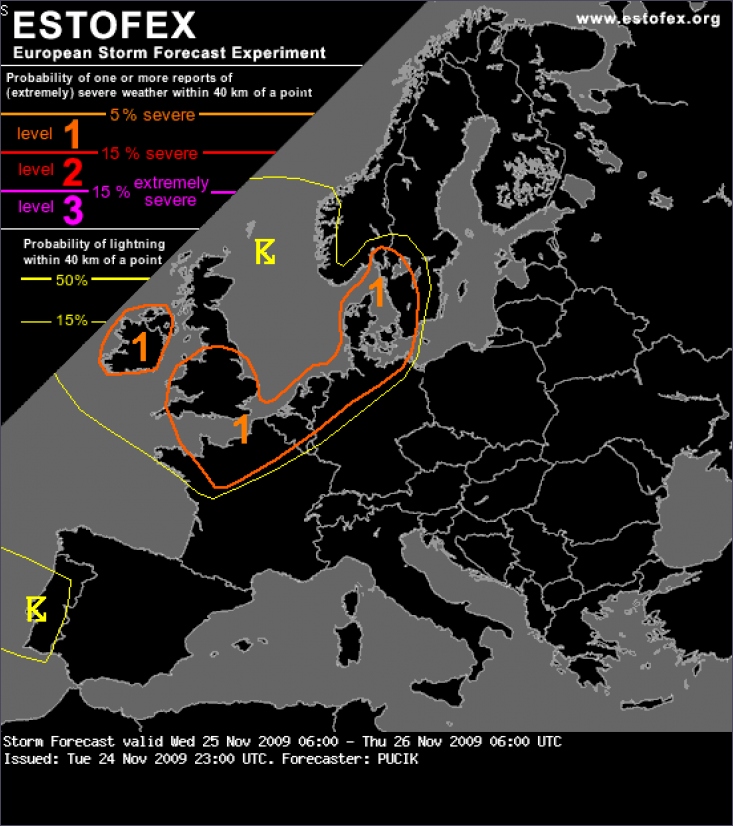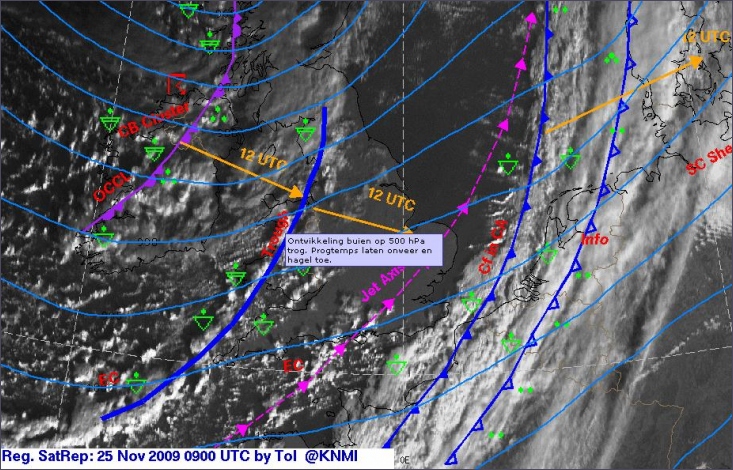A level 1 was issued for England, Northwestern France, BENELUX, N Germany, Denmark, SW Sweden mainly for tornadoes and severe wind gusts.

SYNOPSIS
The major feature on the weather maps is a large cyclone over the Eastern Atlantic, which is expected to reside over the area also during Wednesday. On the forward flank of the cyclone, a southerly strong mid and upper level jet is observed with windspeeds over 50 m/s from 500 to 300 hPa layers. Jet will gradually weaken during the day as the cyclone slowly spreads eastwards. Ahead of the cyclone, a ridge will retreat to the east with its axis stretching from the Mediterranean to Central Europe and Scandinavia around 12 UTC. At the surface, center of the cyclone will cross Northern Scotland with pressure under 960 hPa and then turn northeastwards. At 06 UTC, surface cold front will be passing the British Isles and during the day we expect that it will have passed BENELUX and much of France and Germany.
DISCUSSION
Strong cold front will make its way across the region. Ahead of the front, very strong flow will be present, veering from southerly to south-southwesterly direction with height. At 925 hPa windspeeds above 20 m/s are anticipated and at 500 hPa, values will vary between 40-50 m/s. Models are predicting a belt of enhanced SREH values both in 0-1 and 0-3 km layer. Due to the above mentioned facts, favorable kinematic setup is in store with wind shear values above 40 m/s in 0-6 km layer and from 10-15 m/s in 0-1 km layer.
Strong mesoscale ascent is anticipated in the frontal region and high PV values are advected at upper levels behind the front. One of the detrimental factors to the situation will be a lack of well-developed latent instability. Both GFS and ECMWF predict very marginal values of CAPE, around 200 J/kg in the vicinity of the front. But frontal ascent can at least a bit compensate for the instability. There is a slight chance that with strongly forced convection, meso or misocyclonic circulations manage to develop with attendant threats of severe wind gusts and tornadoes. Due to these threats, Level 1 is issued.
Een uitdiepend lagedrukgebied (00 UTC 960 hPa) noordwest van Schotland trekt langzaam oostwaarts en ligt donderdag om 00 UTC nabij de Shetland Eilanden. Het bijbehorende koufront bereikt woensdag om tussen 7 en 8 UTC de westkust en verlaat om 12 UTC het oosten van ons land. Achter het koufront wordt met een zuidwestelijke stroming polaire lucht aangevoerd.
MODELBEOORDELING:
Deze Uitvoer is consistent en bruikbaar in onze omgeving. Ook ten opzichte van ECHR18- en UKMO00 Uitvoer is er weinig verschil.
WIND:
Zowel in de Hir- als EC Uitvoer verder op de Noordzee een kleine 9 Bft net voor het koufront. We gaan voor de kustdistricten uit van 8 Bft. Aan de zuidflank van de depressiekern woensdag op de noordelijke Noordzee 8-9 Bft. Uitschieters voor het koufront in de kustprovincies 40-45 kt.
BEWOLKING:
In de warme sector SC in een sterk doorgemengde grenslaag. In de nacht lokaal een enkele opklaring, met uitzondering van de kustgebieden. Het koufront heeft een gelaagde structuur. In de loop van woensdagmiddag in de kustprovincies CB's met toppen FL170, doorgroeiend tot FL250 op woensdagavond. Breidt zich donderdag overdag tot over het hele land uit.
NEERSLAG:
In de warme sector lokaal lichte motregen door coalescentie. Activiteit van het koufront is gering, 1-3 mm. Na passage zien we de karakteristieke voorkeurszones voor buien boven de Noordzee en de Nederlandse kust ten gevolg van convergentie boven Het Kanaal. Kans op onweer en korrelhagel. T500 -30 C, toppen FL250. Donderdag overdag overal enkele buien met kans op onweer en korrelhagel.
©KNMI Guidance
Festival Weerman --> www.weerbewaking.nl
Bedrijfsfotografie -->> www.pxpro.nl

 Wat staat er ons vandaag te wachten?
Wat staat er ons vandaag te wachten?





